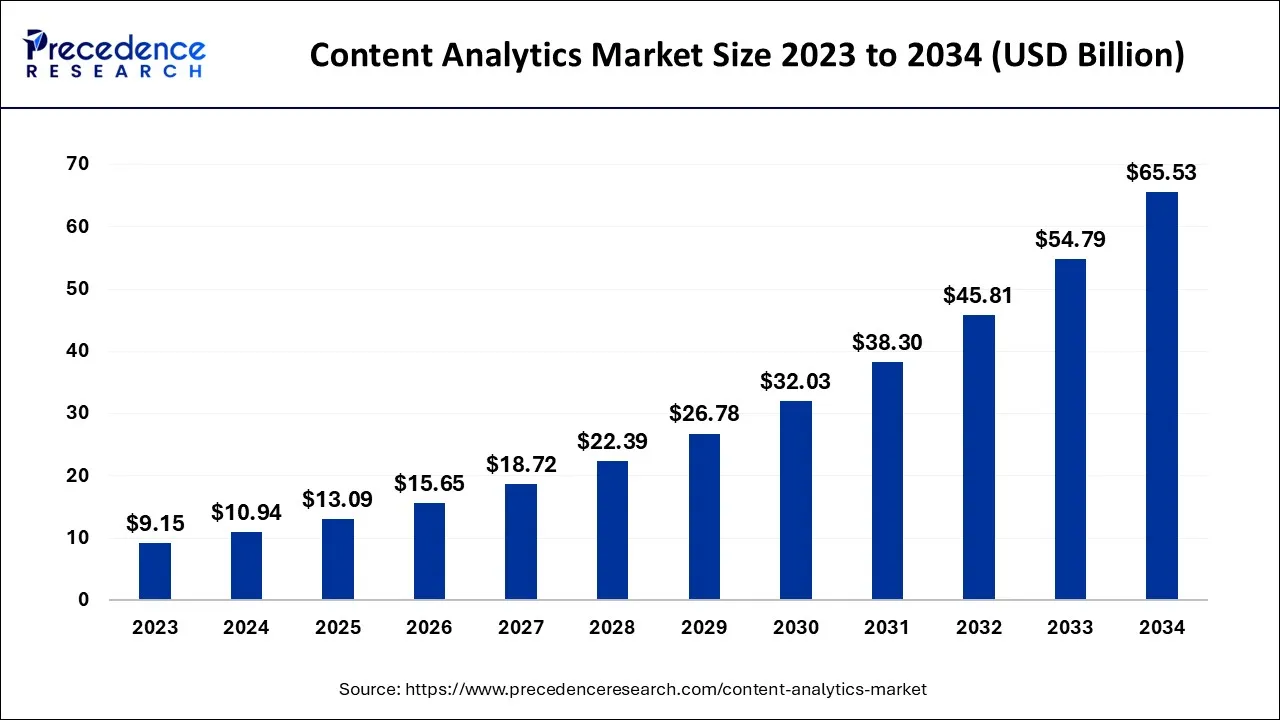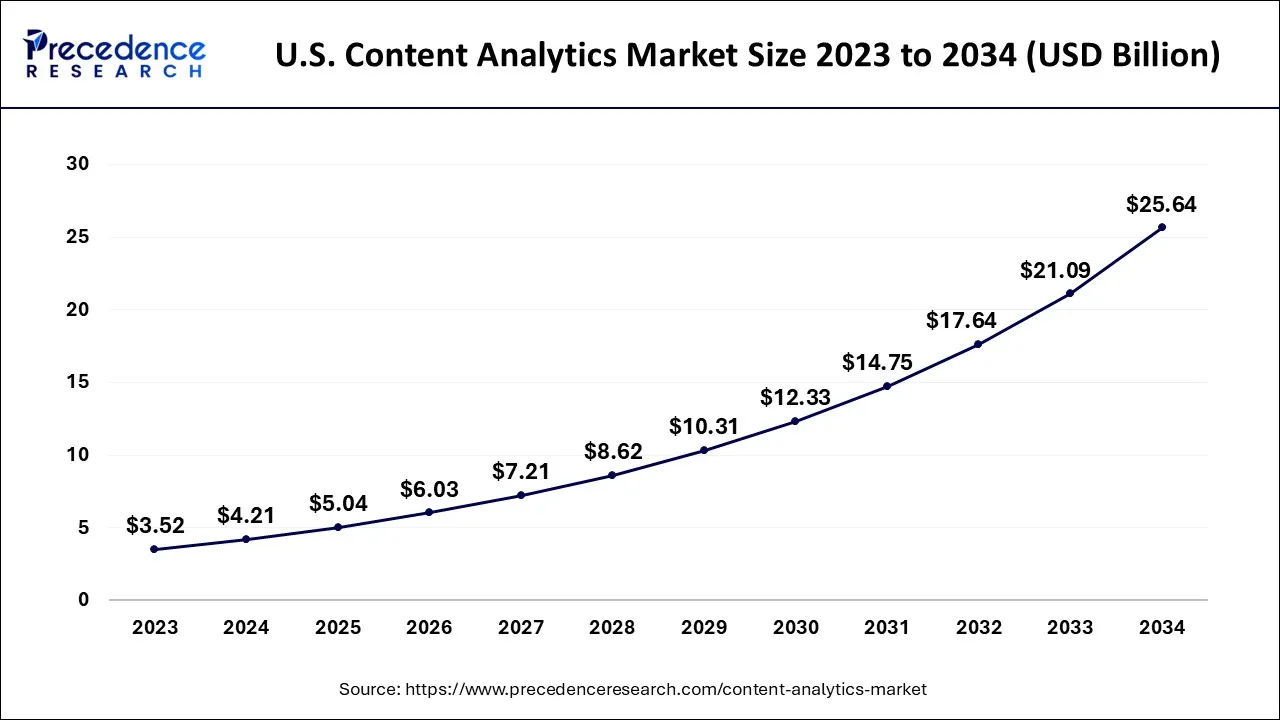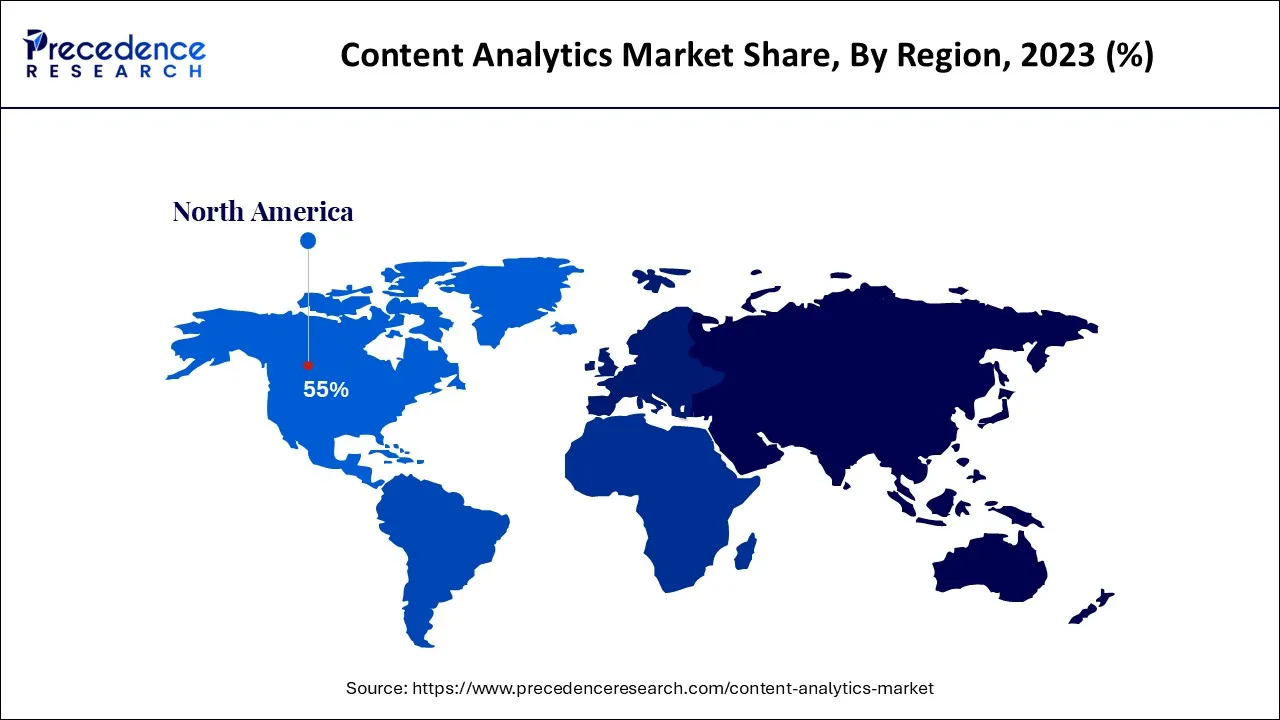January 2025
The global content analytics market size accounted for USD 10.94 billion in 2024, grew to USD 13.09 billion in 2025 and is expected to be worth around USD 65.53 billion by 2034, registering a CAGR of 19.6% between 2024 and 2034. The North America content analytics market size is calculated at USD 6.02 billion in 2024 and is estimated to grow at a CAGR of 19.71% during the forecast period.
The global content analytics market size is calculated at USD 10.94 billion in 2024 and is projected to surpass around USD 65.53 billion by 2034, growing at a CAGR of 19.6% from 2024 to 2034.

The U.S. content analytics market size is exhibited at USD 4.21 billion in 2024 and is projected to be worth around USD 25.64 billion by 2034, growing at a CAGR of 19.8% from 2024 to 2034.

North America held the largest market revenue in the content analytics market in 2023. The growth of the region is attributed due to the rising adoption of technologies in the nations of the region. The growth of industrialization across the region may be expected to the higher demand in the content analytics market. Major players like IBM Corporation, Microsoft, and Oracle are in the United States is one of the market contributing factors in the growth of the content analytics market in these regions.
The increasing retail, healthcare, and other industries' demand for real-time data analytics to manage their data and enhance the profitability of the business would be the driving factor of content analytics in this region. The growing use of social media and online shopping in the younger generation tends to the demand for data analytics and data storage that drives the content analytics market growth.

Content analytics is also known as content intelligence and content management. Content analytics is used for measuring the visitors' traffics on published content such as blogs, articles, press release, etc. content analytics is a specialized tool to serve the requirement of the content team. It is a useful tool for content marketing, digital publication, SEO, and sales enablement. The metrics of content analytics include pageview, social interaction, engaged time acquisition sources, conversions, and more.
Content analytics provides the exact analysis of the content published by the content marketer which content is benefiting their business and fulfills the requirement of the consumer. Content analytics tools help the writer that which content resonates with the audience's requirements. Content analytics helps creator to improve the quality of the content published online. With the increasing demand for the market is due to the increasing demand for advanced content analytics, business intelligence, and real-time content analytics.
Content analytics is used to monitor consumer behavior toward the content that is published on the internet in the form of blogs, articles, press releases, etc. The rising penetration of internet use and increased production of online content and video and to need for monitoring viewer behavior. The increase in the demand of the content analytics market is a rising need for business analysis and improving the quality of the services in an organization.
Content marketers create more content as per the interest habits and requirements of the consumer because of the increasing spending time on technology or online sites. Organizations extract data for content analytics for improving the business and content quality. The rising use of social media platforms by the enterprise in the advertisement of their product and services needs to monitor consumer behavior towards it. All these factors may boost the market demand for content analytics services.
Content analytics is used for understanding which content is most viewed by the reader and how valuable certain content is for the business. Content analytics identify which content ranks on the website and gains the maximum traffic on the site. Content analytics automates very much of the technical tools for improving and monitoring the traffics on the site.
| Report Coverage | Details |
| Market Size in 2024 | USD 10.94 Billion |
| Market Size in 2034 | USD 65.53 Billion |
| Growth Rate from 2024 to 2034 | CAGR of 19.6% |
| Largest Market | North America |
| Fastest Growing Market | Asia Pacific |
| Base Year | 2023 |
| Forecast Period | 2024 to 2034 |
| Segments Covered | By Deployment, By Verticals, and By Application |
| Regions Covered | North America, Europe, Asia-Pacific, Latin America, and Middle East & Africa |
An increase in the use of social media platforms drives the growth of the content analytics market
The increase in the prevalence of social media analytics may drive the content analytics market. The increasing use of social media platforms for advertisement from several organizations may increase the demand for monitoring the traffic by the viewer’s reading the data created by the content marketers to improve the quality and maintain the traffic on site. Social media analytics is used for making decisions regarding business through social media. It had the ability to gathering of data and information from social media platforms to make business decisions.
Social media analytics extract trending offerings and brands. It allows marketers to know the requirement of the consumers and their behavior towards products and services. Social media analytics has the ability to measure the response from social media and other communications. Due to social media analytics, the business knows the high-value features of their products and services. All these properties of social media analytics would drive the demand in the content analytics market.
Time-consuming and has a risk of errors
There are lots of benefits and advantages of content analytics like monitoring the data quality and traffic on the site. Moreover, it had some of disadvantages also in it. The noise researchers do not recommend the use of content analytics due to its higher time consumption. Content analytics deals with a large amount of data and it will consume more time to analyze. Collecting data from different sources and analyzing it consumes a lot of time, so it is one of the market restraining factors of the content analytics market. The interpretation of the relational content analysis is not easy. Researchers may make mistakes while doing that. When a large number of data had been in the process of analysis there is more probability of making errors by them and these may negatively affect the growth of the content analytics market.
Real-Time data analytics in the future opportunity of the market
Real-time data analytics is also known as operational intelligence, real-time data analytics predicts when the device is about to fail. After the collection of data real-time analytics immediately converts it into insights. The insights are used when time is of the essence. With traditional content analytics, a limited set of data can be stored and indexed. Additionally, real-time data analytics is used for operations such as patient safety monitoring and fraud detection. Cutting-edge technology and the Internet of Things (IoT) drive the data to business at higher speed and to process the data business uses real-time data analytics. The rising demand for real-time data analytics to process the data of the business would be the future opportunities for the content analytics market.
The Cloud segment held the largest market share revenue in 2023. The growth of the segment is attributed to the higher adoption of SaaS technology among enterprises. By using vendor-managed infrastructure rather than an organization's internal servers, cloud analytics is a service paradigm that allows data analytics and business intelligence (BI) activities to be performed. It may lessen the risk associated with purchasing servers on-premises network front by using cloud-based analytics.
Cloud analytics is cost-effective because server and software maintenance need in-house expertise. The finest cloud analytics solutions allow users to capture snapshots of statistics, provide commentary for more context, and tag in conversations. As a result, a platform for group decision-making that can be used in real-time and asynchronously is created.
The on-premise data shows a significant growth in the content analytic market in 2023. The growth is attributed to the on-premise properties such as high protection of data and customization according to the need. On-premise gives the maximum control over data to the consumers and gives solutions to their requirements.
The retail and consumer goods segments held a significant market share in 2023. The segment increased due to the maximum use of machine learning, NPL, and artificial intelligence to extract data from online platforms to recognize the habits and requirements of consumers. The data helps to improve the quality of the service and product to enhance the profit of the enterprise.
For Instance, The healthcare segment is expected to grow in the content analytics market over the forecast period. The segment growth attributed to the healthcare organizations uses content analytics to map patient data and evaluate the experience of the patient over the modern healthcare system.
Text Analytics dominated the content analytics market with the highest market share in 2023. Natural Language Processing (NLP) is a subfield that includes text analytics, which tries to automatically extract and classify actionable information from unstructured text that is dispersed over the internet in the form of emails, tweets, conversations, tickets, reviews, and survey replies. Text analytics, often known as text mining, is a multifaceted discipline that bases its production of actionable insights on the collection and processing of text and other linguistic data. With the use of text analytics tools, vast amounts of data from social media, emails, chats, websites, and documents can be easily formatted and analyzed, enhancing corporate productivity with more knowledge.
Social Media Analytics is expected to hold a significant increase during the forecast period. Analytics for social media refers to the gathering of information and indicators that enable you to assess the overall effectiveness of your social media efforts. This aids advertisers in figuring out the social media content formats that connect with their audience the most, allowing them to modify and customize their approach. it is useful for value perception, also known as perceived value, which is how consumers feel about your brand's goods and services in general and if they can satisfy their demands. Demand and even a product's price point are heavily influenced by perceived worth. All these factors refer to the higher demand in the social media analytics market.
Segments Covered in the Report
By Deployment
By Verticals
By Application
By Geography
For inquiries regarding discounts, bulk purchases, or customization requests, please contact us at sales@precedenceresearch.com
No cookie-cutter, only authentic analysis – take the 1st step to become a Precedence Research client
January 2025
July 2024
March 2025
February 2025